Shevlin Sebastian's Blog, page 47
December 20, 2018
The House That Lives On And On
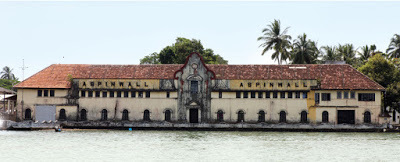
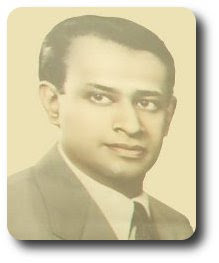
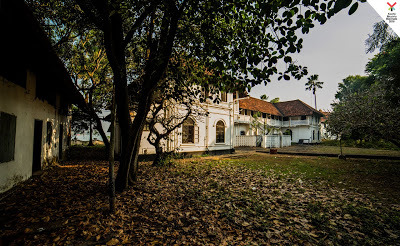
COLUMN: A PEEP INTO THE PAST
Aspinwall House, in Fort Kochi, is more than one hundred years old. Thanks to it being the prime location of the Kochi Muziris Biennale, the building has sprung back into the limelight
Photos: Aspinwall House; John H Aspinwall
By Shevlin Sebastian
The year was 1925. The time: 8.30 a.m. on a Monday morning. A stream of employees entered the Aspinwall House front gate at Fort Kochi. They were the local people, of Portuguese and Goan origin, with names like Pereira and Alphonse. There were Nairs, too. They settled down behind desks in the main office building. Soon, they opened large red ledgers.
Meanwhile, at one side, near the backwaters, a boat arrived. It was filled with products from England: cycles, pumps and engines. It had been brought by a ship which was berthed in an outer channel. After it was unloaded, workers began to fill the empty vessel with material from the large godown at one side. These included coconut oil, coffee, timber, spices, tea, rubber, coir, mat and mattings. All these were being exported to England and other countries.
“The Aspinwall company had a coir factory at Allapuzha,” says city historian VN Venugopal. “Pepper was brought from the high ranges. They had their own rubber plantations at Pullangode in Malabar.”
The company, which has been running for more than 150 years, was set up by a Britisher called John H Aspinwall in 1867.
At Aspinwall House, the general managers lived with their families in two bungalows facing the sea. After work finished at 4.30 p.m. the managers would go home and have tea and snacks. Thereafter, they went to the Cochin Club, which was less than a kilometre away. “The men would play squash, tennis or billiards,” says Venugopal. “Those who were not sports-inclined had a few drinks and played cards. Later, they would go home for dinner.”
On Sundays, the men would play cricket at the Parade Ground. Sometimes, teams would arrive from plantations in Munnar and Wayanad and there would be competitive matches.“It was a comfortable life,” says Venugopal. “A nice bungalow, good food and a comfortable salary. There were a dozen servants to look after you.”
Meanwhile, Aspinwall took several years adding buildings to the House. “He wanted the buildings to last,” says Venugopal. “Lime and mortar were used. Cement had not been discovered then. It was modern looking. There were high ceilings, large windows and wooden furniture. They had a lot of labour in those days to maintain the house.”
On the left of the House, Aspinwall had leased a bit of land to a German shipbuilder by the name of George Brunton. “This later became the Brunton Boatyard period hotel, owned by the CGH Earth Group,” says Venugopal.
On the right, at the present location of the Coast Guard District headquarters, there was the Volkart Brothers and other traders like Harrison and Crossfield and Pierce Leslie. “There was not much competition,” says Venugopal. “Life moved at a leisurely pace.”
Despite that, Aspinwall never relaxed. He was a man with a vision. Aspinwall recommended that Kochi should have a deepwater port. Initially, there was no response. After his death, in 1887, the Cochin Chamber of Commerce took up the request. But nothing happened for decades, although there were several discussions.
“However, in 1920, when Lord Willingdon was the governor of Madras, the Cochin Chamber gave another representation,” says Venugopal. “This time, Lord Willingdon spoke to the Admiralty in London, and an engineer Robert Bristow came on April 13, 1920, to do a survey.
Says historian Sreedhara Menon: “It took some time for the British authorities to realise the commercial and strategic potential of Kochi as a port and take the necessary steps for its development as if to compensate for the earlier neglect.”
But it took 21 years before the port could start functioning because it took a lot of effort to make an approach channel from the deep sea to the inner harbour. The port began operations on May 26, 1928. And Aspinwall's wish finally came true.
But something he never imagined is also taking place now. The House has been leased to the Kochi Biennale Foundation which is holding an international art festival for the past few years.
And the building has made an impact. “When I saw Aspinwall House for the first time, my initial reaction was, ‘My God, this is an incredible space’,” says Biennale Founder Bose Krishnamachari. “Visitors have told me that the House exudes a charm and is a character in its own right. What is great for me is that you can explore it like a historical architectural place. There is always an exchange between the buildings and the sea as well as the land. Lastly, Aspinwall House looks and feels new, even though it is more than 100 years old.”
(The New Indian Express, Kochi)
Published on December 20, 2018 01:05
December 17, 2018
Tattoo Initiative For Women Cancer Survivors

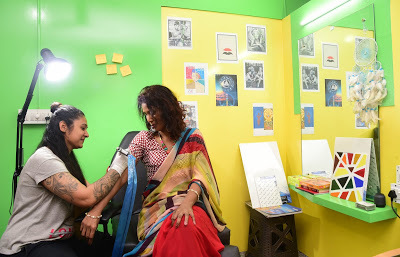
The Kochi-based tattoo artist Ankita Jain’s work on cancer survivor Pooja Stanslas was a transformative experience for both
Photos: Ankitha Jain; Ankitha with Pooja Stanslas. Both by Albin Mathew
By Shevlin Sebastian
On most mornings, when Pooja Stanslas, a third-generation Malaysian of Indian origin looked at the mirror, after her bath, at her home in Kochi, she would feel depressed. Right across her right breast, there was a white scar. It was a grim reminder of the close shave she had: a small area had become malignant. At that time, in 2016, she had been living in Colombo. So, through surgery, the tumour had been removed. “To be careful, they removed more than what was necessary,” says Pooja. “So there is a rather large scar.”
Pooja, who works as an online journalist, toyed with the idea of doing cosmetic surgery. But she felt she should do something less invasive. So she felt tattoos would be a safe option. Through a mutual acquaintance, she came to know that the Delhi-born Ankita Jain was running a set-up called the ShivOham Tattoo studio at Kochi
So, Pooja got in touch with Ankita, who was initially apprehensive. “This was the first time I was getting such a request,” says Ankita.
She discussed it with her partner Priyanka Sivankutty, who told her, “This could make a difference to Pooja’s life.”
So Ankita agreed. And Pooja came over. They talked and clicked. “Pooja is a very down-to-earth person,” says Ankita. “Her only request was that I should make a mandala.”
So, on a recent November morning, Ankita, 28, got going. She cleaned the tattoo area with antibacterial soap solution and removed tiny hairs with a razor. Thereafter, she drew a mandala with the symbol ‘Om’ at the centre on a stencil and placed it over the breast. Then, using a disposable needle, and working carefully, she did the design, using organic inks. The work took all of three hours. “It has to be done perfectly, otherwise the tattoo will stick out, like as if it is embossed,” says Priyanka.
Everything worked out well. And Pooja is so happy. “Now when I look at the mirror, I feel so confident. The scar had been a constant and painful reminder. So, the trauma is receding. Now I can see the ‘Om’, one of Hinduism’s most sacred mantras and it makes me feel spiritual and grateful for being given a second chance in life."
As for Ankita, it was an elevating experience. “The expression on Pooja’s face when she looked at her tattoo was out of this world,” says Ankita. “I felt so happy that I could bring so much of happiness to her.”
In fact, so overwhelmed was Ankita that she told Pooja she would not be charging for her work. “I am hoping that other breast cancer survivors would avail of tattoos to get over their trauma, and I will do it for free,” she says. “This will enable women to overcome the stigma regarding tattoos.”
She says that Kochi is a conservative city. “Many women are scared because they are not sure about how their husbands, mothers-in-law or society would react if they did a tattoo,” says Ankita. Thus far, most of her women clients have come from the Navy personnel stationed in the city as well as North Indian families. “Most of the women prefer mandalas or floral designs like roses,” says Ankita. “They also like it on the back because as and when it is necessary they can cover it.”
Among Malayalis, it is the men, in the 20 to 40 year age group, who are her clients. “There is a big demand for images of Lord Shiva and Jesus Christ,” says Priyanka.
The tattoo artist is herself covered with tattoos on her arms. She has figures of an angel, a rose, a woman’s face and an image of a handsome young man. “This is how my father looked as a young man,” says Ankita. Unfortunately, her father passed away, aged 45 in 2012 of a heart attack.
She lives with that enduring pain but Ankita is also happy to be in Kochi. She had met Priyanka in Bangalore sometime ago where she had gone to do some freelance work. “Priyanka told me there is scope for a quality tattoo artist in Kochi, so I came in May, last year,” she says. “Kochi is a nice place. I am enjoying myself.”
(Sunday Magazine, The New Indian Express, South India and Delhi)
Published on December 17, 2018 03:06
December 14, 2018
Luxembourg Artist Ruminates About Bandhs
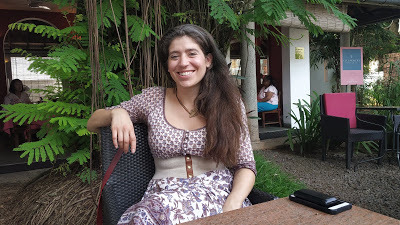 By Shevlin Sebastian
By Shevlin Sebastian When the Luxembourg-based artist Sophie Medawar opened the newspaper on Friday morning (December 14) at Fort Kochi, and read the news about a strike in Kerala, she could not help but go down memory lane.
In August, 2016, when she landed in Kochi, with her husband and daughter, they set out from the airport to Chingoli, near Haripad. As they cruised on the highway, both could not help but notice the rather deserted highway. Sophie’s husband turned to her and said, “Kerala is very quiet. What’s happened?”
Sophie was also equally puzzled. But when they reached their destination the people said, “Oh you managed to come. We have a strike today.”
And that was when Sophie understood why their driver had pasted a notice in Malayalam on the windshield. She was told it read: ‘Tourist transportation’.
Interestingly, Sophie has had her own experience of a strike. This was when she was studying at the ‘Academie Julian’ art school in Paris. On her second day, when she stepped out on the Boulevard Saint Germain to go to college, she saw people shouting and walking past.
Soon, the police fired teargas canisters. In response, the strikers also let off small explosions. This resulted in white, red, blue and green smoke. “It created a fog and the police could no longer see the rioters properly,” says Sophie. “It was amazing. Thankfully, there was no violence and I was able to reach the college safely.”
Sophie pauses and says, “The French are masters of the strike. And they are still at it. Although the riots in Paris today have become violent.”
For Sophie, that initial experience in Paris of a strike was a novel one. That’s because, in Luxembourg, there are no strikes at all. “It is a very quiet country,” she says. “In fact, the last strike I remember was when I was 12 years old.”
A boy had been run over by a bus because there were no proper barriers near a school. So the people protested. “We have never had a strike for political reasons,” she says.
Incidentally, the country has a population of only six lakh or, as Sophie says, “That is the same number of visitors that are expected to arrive for this year’s Biennale.” So, because of their small population, they can pass messages directly to their politicians. And there are swift responses from the powers-to-be.
“But having said this, in my travels, I have seen strikes in many parts of the world,” says Sophie. “It’s a part of life for many people, not only for Malayalis.”
(The New Indian Express, Kerala editions)
Published on December 14, 2018 22:02
December 13, 2018
A Sight To Behold

On a recent visit to Kochi, the visually-challenged Preeti Monga talks about the battling life she has led and about her Delhi-based NGO Silver Linings
By Shevlin Sebastian
When the visually-challenged Preeti Monga, the CEO of the NGO Silver Linings landed at Kochi airport on a recent evening, after a flight from Delhi, she immediately noticed the difference. “The smell was different,” she says. “It was fresh and slightly salty. But it was much warmer than Delhi. There were not too many bumps on the road. Traffic seemed to be less. It seemed to be a prosperous place. And there was far less horn-blowing than in Delhi.”
And she liked the people. “People in the South are much more humane than those in the North,” she says.
Preeti had come to give a talk organised by Aster DM Healthcare. The event was held to recognize the contributions of differently-abled individuals. Preeti’s talk was broadcast live to about 17,700 employees globally.
It has been a long journey for the 59-year-old. At the age of six, she lost her eyesight.
“The damage happened during the first three months of my birth,” she says. “I had been given a smallpox vaccine, which caused an allergy in my eyes. The allergy went away after a month. At that time, I had a functional eyesight. Then it started to deteriorate.”
Soon, she developed Retinitis Pigmentosa, which led to a complete loss of eyesight. Thereafter, for the next several years, Preeti went through a trying time. She was thrown out of a regular school when she was in Class 8 because of her blindness. “That was the time when I realised the gravity of my problem,” she says.
Preeti’s parents took her to a blind school in Delhi. But the school was in such a bad condition, that her parents did not want to leave her there. “The school did not admit day scholars,” says Preeti.”So I stayed at home and read a lot.”
Her parents made her learn the sitar for eight years but she did not have an aptitude. Meanwhile, when she became a young woman, she developed an urge to get married.
“If people with sight have a right to live in this world, so did I,” she says. “So, I thought I should get married like my cousins and friends.”
But it was not easy. She faced rejection from hundreds of boys because nobody wanted to marry a blind girl. Eventually, Preeti found a man who said yes. But it turned out to be a bad marriage. She walked out after 11 years with her two children, Fiona and Mark.
Desperate to earn a living, she did not know what to do. She had only studied till Class 10. She stayed with her parents and they were paying for the expenses of the children, like the school fees. She did not feel good about it.
At this time, in the 1980s, aerobics had become a fad. So, she started teaching it. Preeti did well and conducted several classes a day.
In order to increase her income, she started selling pickles of a Delhi-based company, under the brand name of ‘Granny’s Pickles’. “I would go from door to door, shop to shop, street to street,” she says. Soon, she was selling double the number of bottles sold by the entire sales team. The company offered her the job of marketing and sales head. It was while there that she met Ashwani Monga. “I felt that he is a great human being,” she says. “So I proposed, but it took Ashwani a month before he said yes. And now we have been married for 22 years.”
Asked about Indian society’s attitude towards blindness, Preeti says, “This world has been made by sighted people for sighted people. There is no consideration that a blind person needs to use the same space. We have to learn to adjust. People feel that we are alien. They ask us how do we eat, walk or dress. But the technology of today helps us to use the phones and the computers, as efficiently as everyone else.”
That was when Preeti began a campaign among corporates to urge them to hire blind people.
Preeti has other suggestions. “If you give quality and value education from day one, and include blind children in the mainstream schools, they can do well,” she says. “One of our children got 88 per cent in her Class five final exams in a regular school. She uses an e-book reader.”
In 2006, Preeti set up her NGO Silver Linings. This is aimed at blind girls. And there is a reason for that. “I realised that the blind female child is the most marginalised in society,” says Preeti. “She is ignored by the family as well.”
At the moment she is running a hostel and a preparatory school. Later, these children will be sent to mainstream schools. “We also have another programme called Dignity, for working blind women,” says Preeti. “We offer whatever help required, like cooking and daily-use materials.”
It has been a rich and fulfilling life which she has chronicled in two books -- ‘The Other Senses -- An inspiring true story of a visually-impaired person and her road to success’ and ‘Flight Without Sight’, both available on Amazon.
And her tips for blind people are simple: “Work hard and believe in your abilities.
Learn everything possible. You have to equip ourselves with all that there is to learn. In other words, you must have a fighting spirit. You should take responsibility for your lives and not wait for other people to do something for you.”
-----
An encounter with Khushwant Singh
Preeti Monga went to meet the famed writer Khushwant Singh at his apartment in Delhi to get some help. She was accompanied by her assistant Aditi. Preeti rang the bell. Khushwant opened the door. Then he said, “Hello Preeti, how are you? Please come in.” Then he took Aditi’s hand and led her in.
Preeti was left standing at the door. Preeti said, “Mr Singh, I am here.”
Khushwant came back and said, “What, you are Preeti. I thought she was the blind one and you are the assistant.”
Preeti smiled. Khushwant said, “I have always got the better of the public till today. You are the only one to baffle me. You don’t look blind at all.”
(The New Indian Express, Kochi, Thiruvananthapuram and Kozhikode)
Published on December 13, 2018 21:30
December 12, 2018
First sampling of Kochi Muziris Biennale indicates a sumptuous feast for the eyes

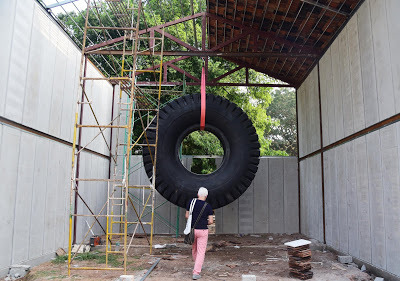
By Shevlin Sebastian
Photos: Curator Anita Dube (left, with microphone) in the hall which contains the work of Gond-couple Subhas and Durgabai Vyam; Massive tyre: Installation work by Danish artist EB Itso. Pics by Albin Mathew
Curator Anita Dube sounds hoarse. “I have been working till 3 a.m. for the past few days,” she says, as she starts a preview tour of the Kochi Muziris Biennale on December 11. And the first stop is a building called the ‘Coir Godown’. This was the original name given to it during the time when the Aspinwall Company (founded in 1867) was functioning at the Fort Kochi location.
But Anita’s voice is sombre as she shows the textile works of the artist Priya Ravish Mehra. “Priya had focused on the marginalised community of Rafoogars of Najidabad, Uttar Pradesh,” says Anita. “I wanted to pay homage to an artist and a colleague who is no longer there.” Priya had died in May this year of cancer at the age of 57.
In a nearby room, Mexican artist Tania Candiani has transformed a traditional weaving loom into a musical instrument with strings. An assistant plays the strings and creates a sound similar to the sitar.
Noted photographer Sunil Janah (1918-2012) has shown searing photographs of the Bengal Famine of 1943. “The mood will change from building to building,” says Anita. “Because we are living in very dark times.”
At one section, when Anita climbs up the stairs, she says, “The upstairs rooms are apocalyptic. There is the work of an artist called Radendo Milak and Anju Dodiya, who focuses on the battle of the sexes.”
Even as she talks, nails are being hammered in, and work goes on. Manoj Nair, Editorial Director of the Biennale says, “The work started late because of the floods, and so many of the carpenters and electricians were not available, as they were busy trying to repair their own homes.”
One of the exhibits which will have resonance is the work by Sue Williamson, which consists of several white T-shirts. “These belonged to people who were sent on slave ships from Kochi to work in South Africa,” says Anita. “Sue did research and found out their names.” On the shirts Sue has printed the following: Name: Jacob. Place of birth: Malabar. Age: 12. Seller: Antony. Buyer: Aram. “Sue has dipped the shirts in a moat in South Africa and dirtied them,” says Anita.
What is going to be an eye-catcher is a huge tyre, weighing 370 tonnes, and made by JK Tyres, which is hanging from a height at the centre of Aspinwall House. “This is called developmental mobility and the concept is by Danish artist EB Itso,” says Anita. “The world has invented the wheel and he wants to show the oppressive nature of the discovery as we go forward.” This is set to to become ‘The Spectacle’ of the Biennale.
Another project which is bound to create an impact is by the Gond artist-couple Subhas and Durgabai Vyam. It is a stunning work, where the entire four walls of a hall are filled with marine plywood etchings. “They are telling the stories about their myths, and their lives,” says Anita. “It is a world full of animals and people. Every inch of the walls has been covered with their work, the opposite of minimalism.”
This sampling seems to indicate that this Bienalle is also headed in the same direction as the previous Biennales: a sumptuous feast for the eyes and plenty of food for thought.
(The New Indian Express, Page 1, Kerala editions)
Published on December 12, 2018 00:11
December 10, 2018
The Feminine View
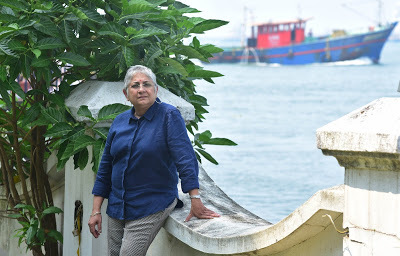
Anita Dube, the first woman curator of the Kochi-Muziris Biennale, talks about what to expect in the fourth edition
Photo by Albin Mathew
By Shevlin Sebastian
Anita Dube was chatting with some artists in Kuala Lumpur recently when one of them said, “Have you heard of Pangrok Sulap.” The curator of the Kochi-Muziris Biennale shook her head. So, she was shown a video.
Pangrok is a collective of artists in their twenties who stay in the state of Sabah. And they have a unique art form. First, they carve words and images in reverse onto a wooden board. Then they put rolling ink on it. Thereafter, they place cloth or paper and dance on it. Then they pull away the paper or cloth and a beautiful illustration is formed. “It was fantastic,” says Anita. “I got so excited.”
Not surprisingly, they have been invited to participate in the fourth edition of the Biennale at Kochi (December 12-March 29, 2019). More than 100 artists will take part, from countries as diverse as Lebanon, Japan, Vietnam, Cuba, South Africa, French Guyana, Poland, Spain and Israel. Interestingly, Anita has avoided the power centres of the West, like the UK, USA, and Europe. “I wanted to give a chance to those who are on the margins of international art,” she says.
And as the first woman curator, it is also no surprise that more than half the artists will be women. “They do not get as many opportunities as the men,” says Anita. “So I wanted to correct that.”
The theme, incidentally, is titled ‘Possibilities of a non-alienated life’. And Anita came to it through prolonged thinking and reflection. “The first question I asked myself was who is my primary audience?” she says. “Is it the one percent that goes to Venice, Sharjah and the Kochi Biennales? Or is it the six lakh spectators who came to the last edition with no stake in culture except for a thirst for aesthetic knowledge?”
And she realised that she needed to showcase accessible artworks for the majority. But her unique idea, which probably has not been done in any Biennale ever is to enable the visitors to become participants. So, apart from the exhibition area, Anita is setting up a pavilion where anybody could come and speak, show a film clip, or discuss about a topic that is very important for them. “You could even sing a Malayalam song,” she says. “I am hoping conversations could develop, and arguments could be had.”
At the Pepper House, at Fort Kochi, on a recent November morning, the sixty-year-old sits at a wooden table in the cafe, looking exhilarated but clearly tired. Since April last year, she has been doing an endless and hectic travel to different countries. “I met so many interesting artists, and had enlightening conversations,” she says. “It has been a once-in-a-lifetime experience.”
Interestingly, she says, it will change her art in some way. “I will have to reevaluate my work,” says Anita. “If you are a writer and you read a great novel, then you know where you stand. It has been a humbling experience for me.”
Asked about the trends in international art these days, she says, “There are so many, like performance and installation art. But perhaps the hottest trend is social practice. The artists are active as social beings like Pangrok is,” she says.
Meanwhile, Anita’s activity as an artist or social being was not preordained. She grew up in Lucknow, one of four children of doctors. In fact, her father Dr PC Dube was well known as the Head of the Department of Surgery in King George Medical Hospital. Both her parents ran a ten-bed nursing home. “So art was very far from our family,” she says. Nevertheless, Anita felt its stirrings within her.
So, she did her MA (History) from Lady Shri Ram College in Delhi. Thereafter, she did art history at MS University in Baroda. “I started to visit art exhibitions in college,” says Anita. “I wrote poetry. But when I touched clay and wood, I knew that I had found my destiny.” Anita made her mark through sculpture, photography, video and installation art.
Finally, when asked whether she was nervous about how people would react to her selections for the Biennale, Anita says, “I can only do what I can do. And I think I have done my best. You cannot please everybody. There will be some who might not like my choices but I don’t mind at all.”
(Sunday Magazine, The New Indian Express, South India and Delhi)
Published on December 10, 2018 21:46
December 9, 2018
When The Locals Said, ‘Thank You’
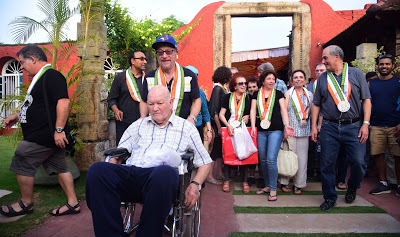
The local community at Jew Town felicitates the Jews who had come from all over the world for the 450th anniversary of the Mattancherry Paradesi Synagogue
Photos: Some of the Jews pictured at the felicitation meeting. Sitting on a wheelchair is the 80 plus Ellis Roby, who lives in Israel. Photo by Albin Mathew. Travel guides put up a banner which says, 'Welcome to Kochi. We love Israel' in Hebrew. One of them waves an Israeli flag. Photo by SS
By Shevlin Sebastian
As the all-woman chenda team set out from the Mattancherry Paradesi Synagogue people looked out from the nearby shops, houses and terraces. Behind the drummers were a motley group of Jews in their sixties, seventies and eighties. Some wore T-shirts, and shorts, while others were in jeans, while several had caps. Ellis Roby, in his mid-eighties, from Israel was seated in a wheelchair.
At the end of the road, three tour guides raised a banner. On it was a Star of David. Beneath it was written two lines in Hebrew. The first line said: ‘Welcome to Kochi’ followed by ‘We love Israel’. And under it was the symbol of the holy Hanukkah candle holder. As one guide waved the Israeli flag, the other said, “We want to show our appreciation of the Jews.”
So did the the Kerala Handicraft Dealers and Manufacturers Welfare Association, the Kashmiri Handicrafts Association and the local community. The Jews had come to celebrate the 450th anniversary of the Mattancherry Paradesi Synagogue. And the locals decided to honour the Jews.
Saus Junaid Sulaiman, the secretary of the Kerala Handicrafts Association: “We are grateful to the Jews because thanks to the presence of the synagogue we are on the world map. And for decades we have been having a steady business as a lot of Jews come from all over the world to pray at the synagogue.”
Leading hotelier Jose Dominic said, “Many of the Jews left in their teens and now they are all senior citizens. The relevance of this celebration is that there will probably not be another celebration like this.”
At the public meeting, in the Ginger House Restaurant, the Los-Angeles based David Hallegua said, “When I get ready to leave this world I know where my soul is going to be. It is going to be by the fishing nets in Fort Kochi, where I grew up as a little boy, spending time with my grandparents, waking up in the morning, hearing a ship’s siren, and hearing the waves hit the banks and the sound of seagulls flying.”
Essie Sassoon, who lives in Israel, said, “The Jews have been driven out from every other country, but India accepted us. We were allowed to live peacefully and practise our religion. This was very important for us. The authorities would call us and ask when was the date of our Rosh Hashana and Yom Kippur festivals so that they could avoid holding public examinations on those days. Where can you find such a caring relationship anywhere in the world?”
And then up stepped the American Steve Hertzman, who brought the house down, when he said, “Sometimes I feel like a colonial plunderer because I managed to pluck one of the most valuable gems in Jew Town: my wife Linda.”
As for Nima Regev, who studied in St. Mary’s convent school, Fort Kochi, St. Teresa’s and Maharaja’s College, her fondest memory was of the ulsavams (festivals). “We would hear the sound of the chendas and rush out of the house,” she said. “Whenever I come here, it is as though I have never left.”
There were felicitations from KV Thomas, MP, George Fernandes, MLA, KJ Soman, former Mayor of the Kochi Corporation and other dignitaries.
The function concluded with the singing of the Israeli national anthem followed by a powerful rendition by the Jews of the Indian national them. At its conclusion, many Jews raised their hands to the sky.
As Essie said, “You can take a Jew out of India but you cannot take India out of a Jew.”
(The New Indian Express, Kerala editions)
Published on December 09, 2018 18:47
December 7, 2018
Down The Home Stretch
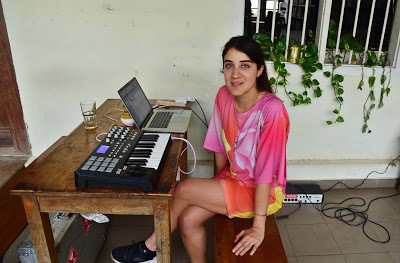
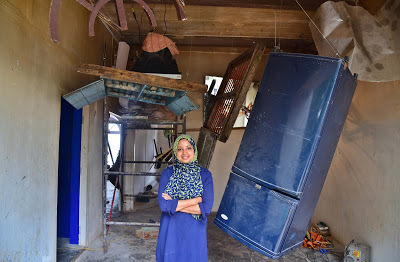
At Pepper House and Aspinwall House, artists work closely with volunteers and the Kochi Biennale Foundation team to get things ready for the opening on December 12
Photos: Brazilian artist Vivian Caccuri; Bangladesh artist Marzia Farhana. Pics by Albin Mathew
By Shevlin Sebastian
On a humid afternoon, Brazilian artist Vivian Caccuri sits at a table in the cafe of the Pepper House, Fort Kochi. She is staring at her laptop, while beside it is a square keyboard. A featured artist of the Kochi Biennale, Vivian is giving finishing touches to her sound installation.
And it is a most unusual one. She has recorded a composition based on the sound of mosquitoes in Kochi. But no surprises to hear the whine of the Kochi mosquitoes is louder than their Brazilian counterparts.
A visitor says, “Malayalis, as well as Indians, are a loud people. So, that could be the reason why the local mosquitoes are louder.”
Vivian laughs and says, “Brazilians can be loud, too, but not in a pleasant way.” But there is a serious aspect to the ‘Mosquito Shrine’ installation. She is researching as to why people get annoyed when they hear the whine of mosquitoes in their ears. Vivian is trying to find answers in the history of America, Africa and Asia and also in the history of medicine. “The relationship between mosquitoes and people have evolved over the centuries,” she says.
In her first visit to the city, Vivian has noticed a lot of similarities between the people of Brazil as well as Kerala. “In both places, the family plays a very important role,” she says. “The warmth of the people is also similar. Another commonality is the love for sweets.”
The visitor says, “Yes, we like sweets, but people are not sweet all the time.”
Vivian laughs again and says, “Absolutely true.”
The Peacock as Metaphor
In a dimly-lit hall, at Aspinwall House, sitting on a chair and clearly taking a breather is Aasma M. Suresh. She is the daughter of the Hyderabad-based artist BV Suresh. Aaasma, who has just completed her masters in visual art from Ambedkar University, New Delhi, is helping her father for the first time.
“There are kinetic, video and audio installations,” she says. “My dad has focused on the subjects of vigilance, mob violence and censorship. He works mostly with commonly-found objects, but for this show, he is using only cane and bamboo.”
Suresh has made a paper mache peacock. “It is a national bird but Dad has made it white to show that the different colours no longer exist in the country,” says Aasma. “In other words, diversity is being attacked. The body looks like a rough cut, like a bird who has undergone a post-mortem.”
Outside the hall, Suresh is standing under a tree.“There is a rising threat to artistic freedom in our country,” he says, as he recalls the harassment of writers like Perumal Murugan, artists like S. Chandramohan and the late M.F. Hussain as well as the killing of activists like Narendra Dhabolkar, NN Kalburgi and Gauri Lankesh. “Recently, I made a film about this, but the organisers of a festival in Mumbai decided not to show it, to avoid any trouble,” says Suresh. “So now, artists are practising self-censorship.”
An artist from Dhaka
Another country where artists are increasingly facing threats and are even murdered is Bangladesh. "It's a different and difficult time not only in Bangladesh but all over the world," says the Dhaka-based artist Marzia Farhana.
But Marzia’s mood brightens when she talks about Kochi. “This is a highly energetic and cooperative place,” she says. “The people are engaged with art deeply. They show a lot of love when they work with artists and their works. I am so happy to see that.”
Interestingly, her work is about the Kerala floods. Marzana is doing a multimedia installation, taking discarded materials from flood-affected areas. One of them is a blue refrigerator, which is hanging upside down from the ceiling. “I am taking a stand on the ecological catastrophe facing the planet,” says Marzia.
High-energy volunteers
Meanwhile, despite moments of self-censorship and rising religious fundamentalism, a group of young volunteers are milling around and having a laugh, even as they make animated conversation. Ritu Lohia has completed a course in architecture and a masters in interior design. The Hyderabad-based youngster says, “This is my first Biennale. I find it very exciting. I hope to meet interesting people.”
Somebody says, “Would you like to fall in love with an artist and get married?”
Rithu thinks about it for a moment and says, “I wouldn’t mind.”
Her Kozhikode-based friend, Hiba Ameena giggles and says, “I never expected such an answer from you.”
“Why not?” says a smiling Ritu. “Artists are interesting people.”
Hiba nods. She runs a travel agency with her mother although she is a trained engineer. But she also has an interest in art. “I wanted to become a volunteer in the previous edition but I was not able to do so,” she says. “But I did visit the Biennale. This year I got selected. I am keen to work with artists and connect with all types of people.”
One volunteer who stands out is Pavneet Singh, with his red turban. He looks vaguely familiar. “Weren’t you there in the last Biennale?” asks a visitor.
“Yes, I was a volunteer then and I am back again,” says Pavneet, a qualified architect, who is from Chandigarh.
Asked what he did in the intervening period, Pavneet says, “I spent nearly nine months working for the Serendipity Art Festival in Goa, till February this year. Now I am in Kochi.”
Asked about whether he desired a regular job, and a steady salary, Pavneet says, “We don’t belong to the generation that wants to work full time. My parents are fine with it, but they told me I must feed myself, which I am doing. So no issues.” Another volunteer Anil Xavier, who is standing next to him, nods in agreement.
When the Gods have a meeting
But the London-based Naga artist Temsuyanger Longkumer has issues but it is with God. “When you look at history, there has always been a dark side to religion,” he says. “I am setting up a structure called ‘God’s Summit’. This is where the Gods of different religions are supposed to be holding a meeting and discussing what has been happening on earth.”
He has taken clips from one hundred films and documentaries. “I selected the films by looking at the topics that they are dealing with and also the words that have been said,” says Temsuyanger. Some of the films used including the recent box office hit, ‘Vendetta’. “After viewing the 90 minute programme, I want people to come to their own conclusions,” he says.
Indeed, from December 12, 2018 till March 29, 2019, around six lakh visitors will come to their own conclusions after seeing numerous artworks from all over the world.
India’s greatest art festival beckons.
Welcome to all!
Fast Files
Cabral Yard: The Hub
The Pavilion at Cabral Yard will be a place where all types of dialogue will take place. Apart from a physical venue for programmes, it will be a space where ordinary people can participate. They can publicly display their work or any online content: from music, to film, literature to viral videos. Participants can speak or perform on open microphones, as well as write and draw on a chalkboard. The Kudumbashree volunteers will be running a community cafe.
Added attraction: Swiss artist Thomas Hirschhorn will be holding a six-hour daily workshop for 30 days inside Yard.
No of artists
95. A majority of them are from the global South. According to the curator Anita Dube, the aim is to rectify an age-old imbalance in the art world that is heavily tilted towards the West.
Continent Break-up
Africa - 11 Asia - 57 Australia - 2 Europe - 15 North America - 8 South America - 1
No of women artistes62. The Indian women artists include Anju Dodiya, Shambhavi Singh, Madhavi Parekh, Nilima Sheikh and Annu Palakunnathu Mathew
Some Themes
Gender Equality Queer, black and feminist art
Art for Kerala
The Kochi Biennale will conduct a live auction of art works by 40 national and international artists on January 18, 2019. It will be held under through ARK (Art Rises For Kerala) in collaboration with SaffronArt. All proceeds will go to the Chief Minister’s Distress Relief Fund
No of visitors expected
Over six lakh
Venues
Aspinwall House
Cabral Yard David Hall Durbar HallKashi Art Cafe Kashi Town House Pepper House TKM Warehouse Map Project Space
Students Biennale
Out of 1500 applications from India and South Asia, 200 student-artists have been shortlisted to participate in the Students Biennale. They come from 80 public and private schools.
(The New Indian Express, Kochi)
Published on December 07, 2018 22:13
November 30, 2018
Oh, It's Yummy!

The just-opened ‘The Secret Sauce’, a hip cafe at Thevara has become a hotspot for youngsters and families alike
Photo: Tarun Eldo Mathew
By Shevlin Sebastian
Singer Don Thomas picks up a guitar that is placed against the wall of ‘The Secret Sauce’ cafe at Thevara, Kochi. With a gleaming bald pate, and wearing red shoes, he soon launches into a song:
“We don't talk anymore, we don't talk anymore
We don't talk anymore like we used to doWe don't love anymoreWhat was all of it for?Oh, we don't talk anymore, like we used to do”
The group of youngsters are half-listening to this cover version of a Charlie Puth song, sitting on benches, as they converse with each other and have chicken burgers, omelette wraps and club sandwiches.
‘The Secret Sauce’, which began on November 2, is a new place to hang around, especially for youngsters in the Thevara area. Located next to the Food Mart, students from the ‘Sacred Heart College’ (SHC), as well as the ‘Brilliant’ tutorial centre in the next building and employees from nearby offices drop in. “Young couples who are dating also find this a nice place to hang around,” says Tarun Eldo Mathew, who is one of the partners and doing his third year in BA English at SHC. “Families also come, especially on the weekends.”
And good food can be had. Because the chef is Nithin K Bahuleyan, who had been associated with a five-star hotel group for the past 18 years and is now a partner in the Sauce. All the items are tasty and delicious.
One of their popular items is the aptly-named ‘Juicy Lucy’. Priced at Rs 160, this is a burger which has cheese, meat as well as potato wedges. Another is the chicken tikka, which has spicy masala in a soft wheat wrap. Then there is the secret club vegetable sandwich which is a triple decker with fresh grilled vegetables, English cheddar and French fries. And one must not forget the Bombay Masala. “This is a street-style vegetable and cheese sandwich,” says Tarun.
However, by mid-December, the cafe will be adding steaks and pastas. “Those who come during the lunch break want a quick meal before they go back to their offices or colleges,” says Tarun. “So we are adding dishes that need less preparation time.”
One regular is Samuel James, a BA student. “What I like about ‘The Secret Sauce’ is the ambience,” he says. “It is very clean and fresh. There is a guitar there. So, if you are a musician, you can come in and have a jamming session. The vibes are positive. A lot of young people come in and we can talk over the food, which is amazing, too. Everything is made very fresh.”
Samuel’s favourite is the chicken calzone. “It’s got chicken, mushroom and cheese and I love the flavours,” he says. “Very sumptuous. And this is the only place in Thevara where you get Continental food. Otherwise, you will have to go to Panampilly Nagar.”
Meanwhile, on asked the meaning behind the name, ‘The Secret Sauce’, Tarun says, “Every chef has a secret ingredient, a secret style. And we feel that Nithin and his team are adding a secret sauce here and there in the dishes.”
As for how Tarun, as a college student got the idea to start the cafe, he says, “I am a foodie. So I always wanted to do something related to food.” But in order to minimise the financial pressure, there are six partners. “Most are family friends,” says Tarun.
But Tarun has other ambitions, too. He wants to be an actor. “I would like to go to a drama school,” he says. In fact, he has already appeared in an ad film for a condiment company. And if he wants, he can take the help of Mollywood star Asif Ali who stays on the 10th floor of his apartment building. “I hadn’t thought about that,” says Tarun, with a laugh.
(The New Indian Express, Koch and Kozhikode)
Published on November 30, 2018 21:44
November 27, 2018
The Crusader Of Languages
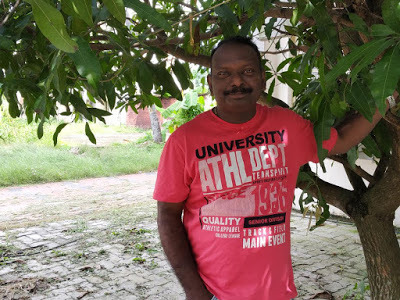
In his 25th year as a translator, the Kochi-based Santosh Alex talks about his career
By Shevlin Sebastian
It had been a long and tiring day for Santosh Alex. Nevertheless, by 7 p.m., at his home at Thevara, Kochi, this Assistant Chief Technical Officer at the Central Institute of Fisheries Technology is at his desk. Next to him are his two older children, Jason, 13, and Jessica, 11, who are doing their homework.
And so is Santosh, in a way. He is translating Benyamin’s short story, ‘Shatru’ into Hindi. The story is an insightful look into mob psychology.
In between his assignment, Santosh has dinner, and later, the children, his wife Jai and their one-month-old baby Jerome go to sleep. But Santosh carries on working, past midnight before he calls it a day.
Santosh is now in his 25th year as a translator. “I have translated directly from English and Malayalam to Hindi, and Hindi to Malayalam,” says Santosh. “For Tamil and Telugu, I do live translations. That means I sit with the author and we work together.”
Some of the authors he has translated include MT Vasudevan Nair, ONV Kurup, K Satchidanandan, Paul Zachariah, NS Madhavan, T Padmanabhan, Punathil Kunjabdulla, Sethu, Madhavi Kutty, Balachandran Chulikkadu, TP Rajeevan, Anwar Ali, Gracy, Rosemary and Sarah Joseph. In total, he has translated the works of more than 150 authors.
Asked about the behaviour of writers, Santosh says, “There are authors who do not open up to strangers and are very guarded. There are a few who live cut off from people, while others are generous and kind and like to have conversations.”
One such person was Jayanta Mahapatra, the legendary Indo-Anglian poet. Santosh met him at his home in Cuttack a few years ago. He had travelled from Vishakapatnam, where he was staying at that time, to give a book of poems written by Jayanata that Santosh had translated into Hindi.
As soon as Santosh entered the house, he saw that Jayanta was having his breakfast.
The poet said, “I am very sorry. I am on pills, which I need to take on time, and have my breakfast soon after. So, without your permission, I am having my breakfast.”
Santosh was taken aback. “I felt that there was no need for Jayanta Sir to apologise, because I was just a beginner,” he says. Nevertheless, Jayanta provided breakfast for Santosh and they started chatting about poems and his magazine ‘Chandrabhaga’. He was helped by the poet Rabindra K Swain who was the assistant editor.
After a while, Rabindra came visiting. Soon, Jayanta and Rabindra asked Santosh to recite the poems. As Santosh did so, he noticed that the duo were whispering in Oriya to each other. After a while, Rabindra said, “Your Hindi recitation does not give any indication that the poem had been translated. It seemed as if it is an original poem. Thank you, it is very nicely done.”
Santosh felt elevated. “I will never forget the kindness and hospitality of Jayanta Sir, who is 90 now,” says Santosh, who has also published his own poems and taken part in international literary festivals in Istanbul and other places.
Meanwhile, when asked how he got interested in doing translations, especially in Hindi, a language not many Malayalis are skilful in, Santosh says, “I was born and brought up in Visakhapatnam and studied in the Kendra Vidyalaya, where I learnt Hindi, English and Sanskrit. My Hindi teacher Malathi Devi engendered in me a love for the language. I was a topper in Hindi during my school days.”
So, it was of no surprise that Santosh ended up doing his MA in Hindi. And somewhere along the way, he got interested in doing translations.
As for the rewards of doing translations, Santosh says, “In my own small way, I am contributing to enriching Indian literature. I am building a bridge between different cultures, especially during a time when there is so much of division in society.” In fact, his work had received appreciation earlier. Santosh has won the prestigious ‘Dwivagessh Puraskaar’ National Award for Translation from the Bhartiya Anuvad Parishad in 2008.
But, of course, there are negatives. There is hardly any money that is paid to translators. “80 percent of the publishers say that they do not sell enough copies,” says Santosh. “This is not true, because I know of books that have gone into the second or third reprints. Most publishers exploit the author as well as the translator. And translators get far less respect than the writer.”
He gives an example. When Benyamin became the winner at the JCB Prize for Literature recently for his work, ‘Jasmine Days’, he received a prize money of Rs 25 lakh, while the translator Shahnaz Habib got Rs 5 lakh. “It should be fifty-fifty,” says Santosh. “Because without the high-quality translation, Benyamin would not have won the award. Nevertheless, I am happy that Shahnaz got a good amount.”
But whether there is any amount or not, Santosh himself is committed to serving Indian literature. He is, in fact, a crusader… of languages.
(The New Indian Express, Kochi, Thiruvananthapuram and Kozhikode)
Published on November 27, 2018 21:35



